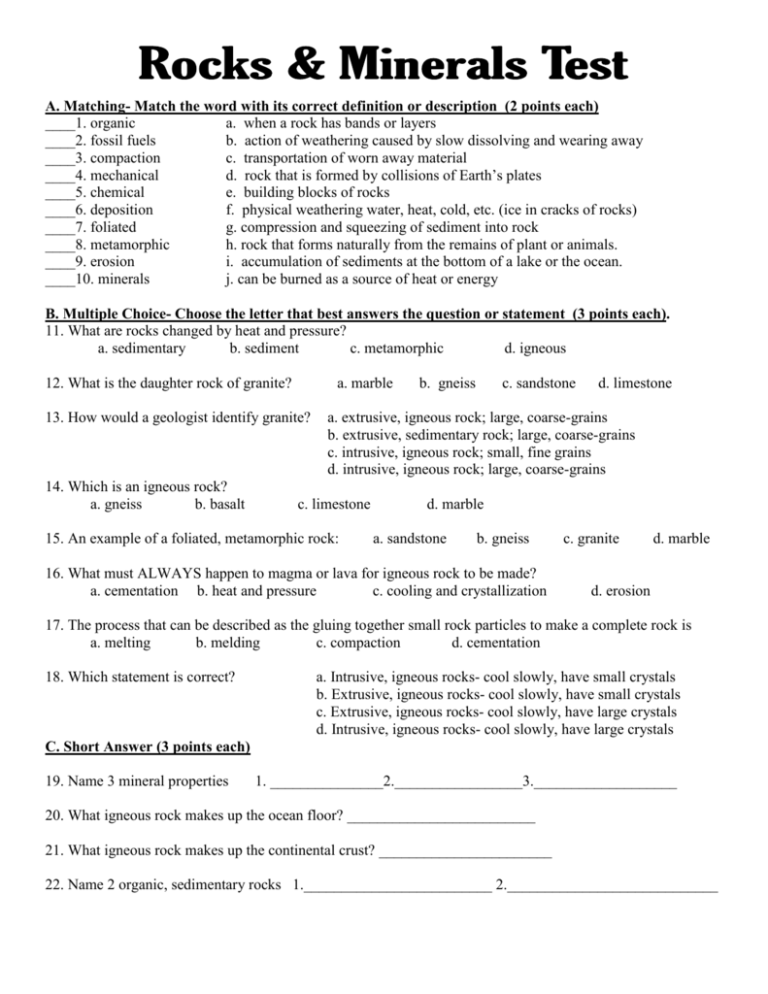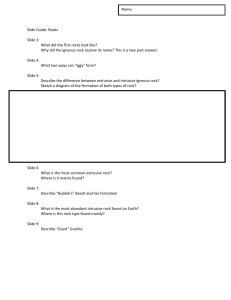Rocks and Minerals Test
advertisement

A. Matching- Match the word with its correct definition or description (2 points each) ____1. organic a. when a rock has bands or layers ____2. fossil fuels b. action of weathering caused by slow dissolving and wearing away ____3. compaction c. transportation of worn away material ____4. mechanical d. rock that is formed by collisions of Earth’s plates ____5. chemical e. building blocks of rocks ____6. deposition f. physical weathering water, heat, cold, etc. (ice in cracks of rocks) ____7. foliated g. compression and squeezing of sediment into rock ____8. metamorphic h. rock that forms naturally from the remains of plant or animals. ____9. erosion i. accumulation of sediments at the bottom of a lake or the ocean. ____10. minerals j. can be burned as a source of heat or energy B. Multiple Choice- Choose the letter that best answers the question or statement (3 points each). 11. What are rocks changed by heat and pressure? a. sedimentary b. sediment c. metamorphic d. igneous 12. What is the daughter rock of granite? a. marble 13. How would a geologist identify granite? 14. Which is an igneous rock? a. gneiss b. basalt b. gneiss c. sandstone d. limestone a. extrusive, igneous rock; large, coarse-grains b. extrusive, sedimentary rock; large, coarse-grains c. intrusive, igneous rock; small, fine grains d. intrusive, igneous rock; large, coarse-grains c. limestone 15. An example of a foliated, metamorphic rock: d. marble a. sandstone b. gneiss 16. What must ALWAYS happen to magma or lava for igneous rock to be made? a. cementation b. heat and pressure c. cooling and crystallization c. granite d. marble d. erosion 17. The process that can be described as the gluing together small rock particles to make a complete rock is a. melting b. melding c. compaction d. cementation 18. Which statement is correct? a. Intrusive, igneous rocks- cool slowly, have small crystals b. Extrusive, igneous rocks- cool slowly, have small crystals c. Extrusive, igneous rocks- cool slowly, have large crystals d. Intrusive, igneous rocks- cool slowly, have large crystals C. Short Answer (3 points each) 19. Name 3 mineral properties 1. _______________2._________________3.___________________ 20. What igneous rock makes up the ocean floor? _________________________ 21. What igneous rock makes up the continental crust? _______________________ 22. Name 2 organic, sedimentary rocks 1._________________________ 2.____________________________ D. True/False—If the statement is true write out the word TRUE, if the statement is false correct the underlined phrase to make it TRUE!!! (2 points each) _________________23. Limestone is the parent rock of marble. _________________24. The most common extrusive, igneous rock is basalt. _________________25. Weathering and erosion of large rocks takes a short amount of time. _________________26. Coal is a type of organic, igneous rock. _________________27. Rocks are mainly classified by how they are created. E. Identification (3 points each) Using the rock dichotomous key provided at the station, identify the rocks given. 28. __________________________ 29. ____________________________ 30. ___________________________ Application (5 points each)31. Thoroughly compare and contrast igneous and sedimentary rocks. 32. Draw an illustration of the rock cycle. Include all types of rocks and the processes that make them. Don’t forget any “shortcuts”. Essays (6 points each)Out of the 4 essay topics, choose only 2 to answer. You must write out which essay number you chose. If writing is required, write in complete sentences or I will NOT grade them. Essay #1. Using your knowledge of the rock cycle and minerals, explain completely your thoughts about the following question “How do humans influence or affect the rock cycle” Essay #2. Based on what you learned about sedimentary, metamorphic, and igneous rocks….Describe the types of places and at what types of plate boundaries where each of these rocks might be made or found. Essay #3 Justify what you think about the question, “Are rocks ever completely destroyed? Essay #4. Design a chart or web that explains what minerals are and their physical and chemical properties








